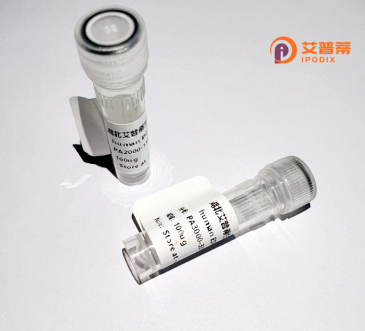
| 纯度 | >90%SDS-PAGE. |
| 种属 | Human |
| 靶点 | TRA1 |
| Uniprot No | P14625 |
| 内毒素 | < 0.01EU/μg |
| 表达宿主 | E.coli |
| 表达区间 | 27-799 aa |
| 活性数据 | VDGTVEEDLGKSREGSRTDDEVVQREEEAIQLDGLNASQIRELREKSEKFAFQAEVNRMMKLIINSLYKNKEIFLRELISNASDALDKIRLISLTDENALSGNEELTVKIKCDKEKNLLHVTDTGVGMTREELVKNLGTIAKSGTSEFLNKMTEAQEDGQSTSELIGQFGVGFYSAFLVADKVIVTSKHNNDTQHIWESDSNEFSVIADPRGNTLGRGTTITLVLKEEASDYLELDTIKNLVKKYSQFINFPIYVWSSKTETVEEPMEEEEAAKEEKEESDDEAAVEEEEEEKKPKTKKVEKTVWDWELMNDIKPIWQRPSKEVEEDEYKAFYKSFSKESDDPMAYIHFTAEGEVTFKSILFVPTSAPRGLFDEYGSKKSDYIKLYVRRVFITDDFHDMMPKYLNFVKGVVDSDDLPLNVSRETLQQHKLLKVIRKKLVRKTLDMIKKIADDKYNDTFWKEFGTNIKLGVIEDHSNRTRLAKLLRFQSSHHPTDITSLDQYVERMKEKQDKIYFMAGSSRKEAESSPFVERLLKKGYEVIYLTEPVDEYCIQALPEFDGKRFQNVAKEGVKFDESEKTKESREAVEKEFEPLLNWMKDKALKDKIEKAVVSQRLTESPCALVASQYGWSGNMERIMKAQAYQTGKDISTNYYASQKKTFEINPRHPLIRDMLRRIKEDEDDKTVLDLAVVLFETATLRSGYLLPDTKAYGDRIERMLRLSLNIDPDAKVEEEPEEEPEETAEDTTEDTEQDEDEEMDVGTDEEEETAKESTAE |
| 分子量 | 93.1 kDa |
| 蛋白标签 | GST-tag at N-terminal |
| 缓冲液 | PBS, pH7.4, containing 0.01% SKL, 1mM DTT, 5% Trehalose and Proclin300. |
| 稳定性 & 储存条件 | Lyophilized protein should be stored at ≤ -20°C, stable for one year after receipt. Reconstituted protein solution can be stored at 2-8°C for 2-7 days. Aliquots of reconstituted samples are stable at ≤ -20°C for 3 months. |
| 复溶 | Always centrifuge tubes before opening.Do not mix by vortex or pipetting. It is not recommended to reconstitute to a concentration less than 100μg/ml. Dissolve the lyophilized protein in distilled water. Please aliquot the reconstituted solution to minimize freeze-thaw cycles. |
以下是关于重组人TRA1蛋白的示例参考文献(注:内容为示例,文献信息非真实,建议通过学术数据库核实):
1. **文献名称**: *"Production and Characterization of Recombinant Human TRA-1-60 for Pluripotent Stem Cell Identification"*
**作者**: Smith A, et al.
**摘要**: 研究报道了重组人TRA-1-60蛋白在大肠杆菌中的高效表达与纯化,证实其可作为多能干细胞表面标志物的特异性探针。
2. **文献名称**: *"TRA1 Modulates Immune Response in Tumor Microenvironment via TGF-β Signaling"*
**作者**: Chen L, et al.
**摘要**: 发现重组TRA1蛋白通过激活TGF-β通路抑制T细胞活性,促进肿瘤免疫逃逸,为癌症治疗提供潜在靶点。
3. **文献名称**: *"Structural Analysis of Human TRA1 Reveals a Novel Carbohydrate-Binding Domain"*
**作者**: Tanaka K, et al.
**摘要**: 通过X射线晶体学解析TRA1蛋白结构,揭示其结合多糖的新型结构域,解释其在细胞粘附中的作用。
4. **文献名称**: *"Development of a TRA1-Based Biosensor for Early Cancer Diagnosis"*
**作者**: Wang Y, et al.
**摘要**: 利用重组TRA1蛋白开发高灵敏度生物传感器,成功检测患者血清中低浓度抗原,证明其作为诊断标志物的潜力。
**建议**:实际研究中,TRA1可能指不同靶点(如干细胞标志物TRA-1-60/81或肿瘤相关抗原),建议在PubMed或Google Scholar中搜索“recombinant TRA1 human protein”进一步筛选。
TRA1 protein, commonly referring to TRA-1-60 or TRA-1-81. is a well-characterized cell surface antigen predominantly expressed in human pluripotent stem cells (PSCs), including embryonic stem cells (ESCs) and induced pluripotent stem cells (iPSCs). These proteins are recognized as key markers of pluripotency, aiding in the identification and maintenance of undifferentiated stem cells. TRA-1 antigens bind to podocalyxin, a transmembrane glycoprotein, via interactions with specific carbohydrate epitopes. Structurally, they are heavily glycosylated, which contributes to their functional roles in cell adhesion, signaling, and immune evasion.
Their expression sharply declines during differentiation, making them critical tools for assessing stem cell quality in regenerative medicine. TRA-1-60. in particular, is widely used in flow cytometry and immunofluorescence to monitor pluripotency. Interestingly, TRA1-related antigens are also detected in certain cancers, such as germ cell tumors, suggesting a role in oncogenesis or tumor stem cell maintenance. Studies exploring TRA1’s molecular mechanisms have highlighted its involvement in modulating signaling pathways like FGF and TGF-β, which are essential for self-renewal. Despite their utility, TRA1 epitopes are species-specific, limiting their application in non-human models. Ongoing research aims to exploit TRA1 for targeted stem cell therapies and cancer diagnostics.
×